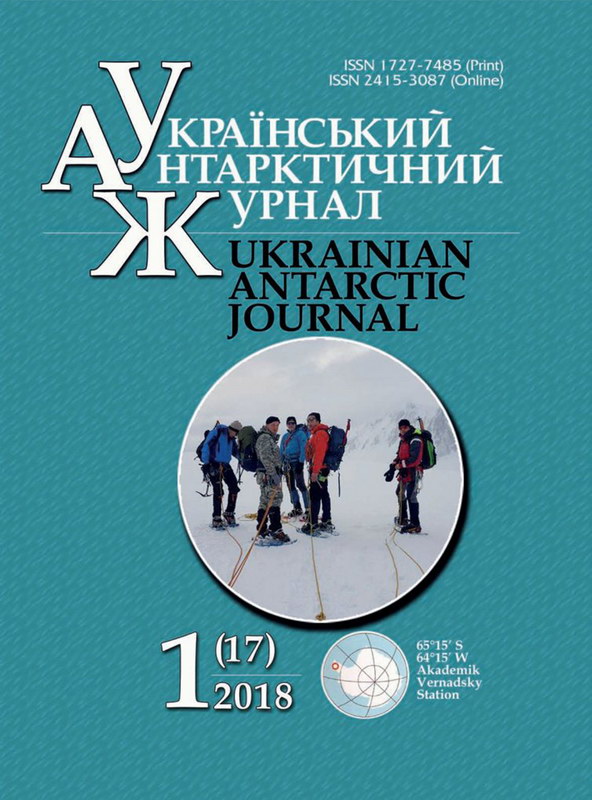On the Possibility of Sounding the Boundaries of the Nothern Auroral Oval by Registrations of High Frequency Signals on Superlong Radio Paths
- ionospheric plasma,
- inhomogeneities of electron density,
- scattering,
- polar ionosphere,
- boundary of auroral oval

This work is licensed under a Creative Commons Attribution-NonCommercial-NoDerivatives 4.0 International License.
Abstract
Objective. Developing a technique for investigation of a dynamic of the equatorial boundary of the night side of the Northern auroral oval using data of registrations of scattered HF signals on superlong radio paths. Methods. Spectral, time, and time-frequency analysis of HF signals from time service stations, recorded at the Ukrainian Antarctic Akademik Vernadsky station (UAS). Selection of the spatial mode of signals scattered on the plasma inhomogeneities of the high latitude ionosphere of the northern hemisphere. The developed method is based on the measurement of the Doppler frequency shift and time of the group delay of the radio signal. Results. The possibility of studying the dynamics of the equatorial boundary of the night side of the Northern auroral oval using characteristics of scattered HF signals of time service stations registered at UAS is demonstrated. Conclusions. In the registrations of HF signals of the RWM station (55.75°N, 37.64°E) at UAS (65.25°S, 64.27°W) it is possible to select the mode scattered on the inhomogeneities of the high-latitude ionosphere of the northern hemisphere. The method for diagnosing the equatorial boundary of the auroral oval by observations on UAS of scattered radio signals from stations of the time service is proposed. It is convenient to use such stations as sources of the probe signal for diagnostic of the ionosphere so far as they have a number of advantages, including low relative frequency instability of master oscillators; weakly directed antennas and sufficiently powerful transmitters thanks to which their signals can be recorded in different regions of the globe; continuous work on a previously known schedule and, finally, the fact that they simultaneously emit at several frequencies, which expands the possibilities of their diagnostic use. The technique does not require additional transmitting devices and expensive antenna systems. The regular measurements using the suggested method allow carrying out the monitoring of auroral ionosphere, which will give the possibility for improving the existent models of its behavior.
References
- Galushko, V. G., Zalizovski, A. V., Pikulik, I. I., Kascheev, S. B., Charkina, O. V. 2016. Pelengovanie VCh signalov, rasseyannyih ionosfernyimi neodnorodnostyami, spomoschyu malorazmernyih antenn [Direction finding of HF signals scattered by ionospheric irregularities using small size antenna]. Radiofizika i radioastronomiya [Radio Physics and Radio Astronomy], 21(3), 231-241. (Іn Russian). https://doi.org/10.15407/rpra21.03.231
- Zalizovski, A. V., Koloskov, A. V., Yampolski, Y. M. 2015. Issledovaniya v Antarktike chastotno-vremennyih harateristik VCh signalov na sverhdalnih radioliniyah [Studying in Antarctica the time-frequency characteristics of HF signals at the long radio paths]. Ukrainskij Antarktychnij Zhurnak [Ukrainian Antarctic Journal], 14, 124-137. (Іn Russian).
- Kascheev, S. B., Zalizovski, A. V., Sopin, A. A., Pikulik, I. I., 2013. O vozmozhnosti bistaticheskogo VCh zondirovaniya ionosfery i signalami tochnogo vremeni [On the possibility of bistatic HF ionospheric sounding by exact time signals]. Radiofizika i radioastronomiya [Radio Physics and Radio Astronomy], 18(1), 34-42. (Іn Russian).
- Koloskov, A. V., Yampolski, Y. M., Zalizovsky, A. V., Galushko, V. G., Kascheev, A. S., La Hoz, C., Brekke, A., Belyey, V.S., Rietveld, M. T. 2014. Set internet-upravlyaemyih VCh priemnikov dlya ionosfernyih issledovaniy [Network of Internet-controlled HF receivers for ionospheric researches]. Radiofizika i radioastronomiya [Radio Physics and Radio Astronomy], 19(4), 324-335. (Іn Russian). https://doi.org/10.15407/rpra19.04.324
- Starkov, G. V. 2000. Planetarnaya dinamika avroralnogo svecheniya [Planetary dynamics of auroral luminosity]. Fizika okolozemnogo kosmicheskogo prostranstva [Physics of the near-Earth space]. Polar Geophysical Institute, Kola Scientific Centre RAS, Apatity, 409-499. (Іn Russian).
- Borovsky, J. E. 1993. Auroral arc thicknesses as predicted by various theories. J. Geophys Res, 98, 6101-6138. https://doi.org/10.1029/92JA02242
- Frey, H. U. 2007. Localized aurora beyond the auroral oval. Rev. Geophys, 45, 1-32. https://doi.org/10.1029/2005RG000174
- Greenwald, R. A., Baker, K. B., Dudeney, J. R., Pinnock, M., Jones, T. B., Thomas, E. C., Villain, J.-P., Cerisier, J. C., Senior, C., Hanuise, C., Hunsucker, R. D., Sofko, G. J., Koehler, J. A., Nielsen, E., Pellinen, R., Walker, A. D. M., Sato, N., Yamagishi, H. 1995. DARN/SuperDARN: A global view of the dynamics of highlatitude convection. Space Sci. Rev., 71, 761-796. https://doi.org/10.1007/BF00751350
- Jayachandran, P. T., MacDougall, J. W., St-Maurice, J.-P., Moorcroft, D. R., Newell, P. T., Prikryl, P. 2002. Coincidence of the ion precipitation boundary with the HF E-region backscatter boundary in the dusk-midnight sector. Geophys.Res. Lett, 29(8). DOI:10.1029/2001GL014184. https://doi.org/10.1029/2001GL014184
- Newell, P. T., Feldstein, Y. I., Galperin, Y. I., Meng, C.-I. 1996. Morphology of nightside precipitation. J. Geophys. Res., 101(A5), 10,737-10,748. https://doi.org/10.1029/95JA03516
- Xiong, C.H., Luhr, H., Wang, H., Johnsen, M. G. 2014. Determining the boundaries of the auroral oval from CHAMP field-aligned currents signatures - Part 1. Ann Geophys, 32, 609-622. https://doi.org/10.5194/angeo-32-609-2014

